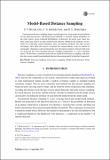Files in this item
Model-based distance sampling
Item metadata
| dc.contributor.author | Buckland, Stephen Terrence | |
| dc.contributor.author | Oedekoven, Cornelia Sabrina | |
| dc.contributor.author | Borchers, David Louis | |
| dc.date.accessioned | 2015-09-07T11:10:02Z | |
| dc.date.available | 2015-09-07T11:10:02Z | |
| dc.date.issued | 2016-03 | |
| dc.identifier | 214296895 | |
| dc.identifier | a38ed61e-7873-4b42-994f-9f13b1acbe2d | |
| dc.identifier | 84958040638 | |
| dc.identifier | 000374695400004 | |
| dc.identifier.citation | Buckland , S T , Oedekoven , C S & Borchers , D L 2016 , ' Model-based distance sampling ' , Journal of Agricultural, Biological and Environmental Statistics , vol. 21 , no. 1 , pp. 58-75 . https://doi.org/10.1007/s13253-015-0220-7 | en |
| dc.identifier.issn | 1085-7117 | |
| dc.identifier.other | ORCID: /0000-0002-5610-7814/work/61978857 | |
| dc.identifier.other | ORCID: /0000-0002-3944-0754/work/72842477 | |
| dc.identifier.other | ORCID: /0000-0002-9939-709X/work/73701091 | |
| dc.identifier.uri | https://hdl.handle.net/10023/7410 | |
| dc.description | CSO was part-funded by EPSRC/NERC Grant EP/1000917/1. | en |
| dc.description.abstract | Conventional distance sampling adopts a mixed approach, using model-based methods for the detection process, and design-based methods to estimate animal abundance in the study region, given estimated probabilities of detection. In recent years, there has been increasing interest in fully model-based methods. Model-based methods are less robust for estimating animal abundance than conventional methods, but offer several advantages: they allow the analyst to explore how animal density varies by habitat or topography; abundance can be estimated for any sub-region of interest; they provide tools for analysing data from designed distance sampling experiments, to assess treatment effects. We develop a common framework for model-based distance sampling, and show how the various model-based methods that have been proposed fit within this framework. | |
| dc.format.extent | 18 | |
| dc.format.extent | 519971 | |
| dc.language.iso | eng | |
| dc.relation.ispartof | Journal of Agricultural, Biological and Environmental Statistics | en |
| dc.subject | Distance sampling | en |
| dc.subject | Line transect sampling | en |
| dc.subject | Model-based inference | en |
| dc.subject | Point transect sampling | en |
| dc.subject | QA Mathematics | en |
| dc.subject | NDAS | en |
| dc.subject | BDC | en |
| dc.subject | R2C | en |
| dc.subject.lcc | QA | en |
| dc.title | Model-based distance sampling | en |
| dc.type | Journal article | en |
| dc.contributor.sponsor | EPSRC | en |
| dc.contributor.institution | University of St Andrews. School of Mathematics and Statistics | en |
| dc.contributor.institution | University of St Andrews. Marine Alliance for Science & Technology Scotland | en |
| dc.contributor.institution | University of St Andrews. Scottish Oceans Institute | en |
| dc.contributor.institution | University of St Andrews. St Andrews Sustainability Institute | en |
| dc.contributor.institution | University of St Andrews. Centre for Research into Ecological & Environmental Modelling | en |
| dc.identifier.doi | 10.1007/s13253-015-0220-7 | |
| dc.description.status | Peer reviewed | en |
| dc.identifier.grantnumber | EP/I000917/1 | en |
This item appears in the following Collection(s)
Items in the St Andrews Research Repository are protected by copyright, with all rights reserved, unless otherwise indicated.

